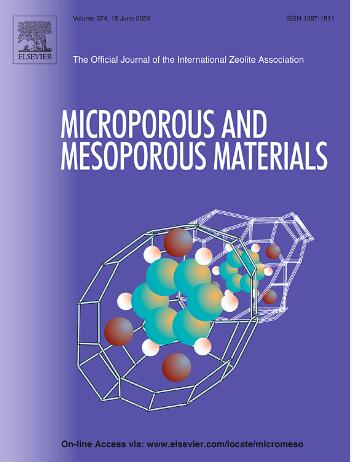Two-stage synthesis of Fe-UZM-35 zeolite promoted by Fenton's reagent and its application in hydroxylation of phenol
IF 4.8
3区 材料科学
Q1 CHEMISTRY, APPLIED
引用次数: 0
Abstract
The synthesis of UZM-35 zeolite suffers from long crystallization times (4–14 days), irregular product morphology, and low purity and crystallinity, which significantly limit the material's potential applications. In this study, Fe-UZM-35 zeolite was synthesized using a two-stage crystallization method to address these issues. Initially, Fenton's reagent was employed as both an iron source and a hydroxyl radical generator, taking advantage of the hydroxyl radical's ability to accelerate zeolite nucleation. The system was first microwave-heated at low temperatures to achieve rapid and uniform nucleation, followed by conventional heating at higher temperatures to promote uniform growth of the zeolite crystal nuclei. The effects of Fenton's reagent dosage, low-temperature pretreatment duration, and high-temperature crystallization time on the zeolite's crystallization process were thoroughly investigated. It was found that Fe-UZM-35 zeolite with high crystallinity could be obtained under the conditions of a H2O2/FeIIO ratio of 2.5, a 5-h low-temperature pretreatment, and a 3-day high-temperature crystallization period. Several Fe-UZM-35 catalysts with varying iron contents were synthesized under these optimized conditions. The catalysts crystallinity, morphology, pore structure, iron species distribution, and acid properties were characterized using XRD, SEM, N2 physisorption, UV–Vis, H2-TPR, and NH3-TPD, respectively. Selected catalysts were evaluated for catalytic performance in the hydroxylation of phenol as a model reaction. Results showed that the catalytic activity of iron-based zeolites is influenced by multiple factors, with Fe-UZM-35 zeolites exhibiting higher relative crystallinity, surface area, Lewis acid density, and hydrophobicity delivering the best catalytic performance.

求助全文
约1分钟内获得全文
求助全文
来源期刊

Microporous and Mesoporous Materials
化学-材料科学:综合
CiteScore
10.70
自引率
5.80%
发文量
649
审稿时长
26 days
期刊介绍:
Microporous and Mesoporous Materials covers novel and significant aspects of porous solids classified as either microporous (pore size up to 2 nm) or mesoporous (pore size 2 to 50 nm). The porosity should have a specific impact on the material properties or application. Typical examples are zeolites and zeolite-like materials, pillared materials, clathrasils and clathrates, carbon molecular sieves, ordered mesoporous materials, organic/inorganic porous hybrid materials, or porous metal oxides. Both natural and synthetic porous materials are within the scope of the journal.
Topics which are particularly of interest include:
All aspects of natural microporous and mesoporous solids
The synthesis of crystalline or amorphous porous materials
The physico-chemical characterization of microporous and mesoporous solids, especially spectroscopic and microscopic
The modification of microporous and mesoporous solids, for example by ion exchange or solid-state reactions
All topics related to diffusion of mobile species in the pores of microporous and mesoporous materials
Adsorption (and other separation techniques) using microporous or mesoporous adsorbents
Catalysis by microporous and mesoporous materials
Host/guest interactions
Theoretical chemistry and modelling of host/guest interactions
All topics related to the application of microporous and mesoporous materials in industrial catalysis, separation technology, environmental protection, electrochemistry, membranes, sensors, optical devices, etc.
文献相关原料
公司名称
产品信息
麦克林
KI
阿拉丁
Sodium thiosulfate
阿拉丁
Fumed silica
阿拉丁
FeSO4·7H2O
 求助内容:
求助内容: 应助结果提醒方式:
应助结果提醒方式:


